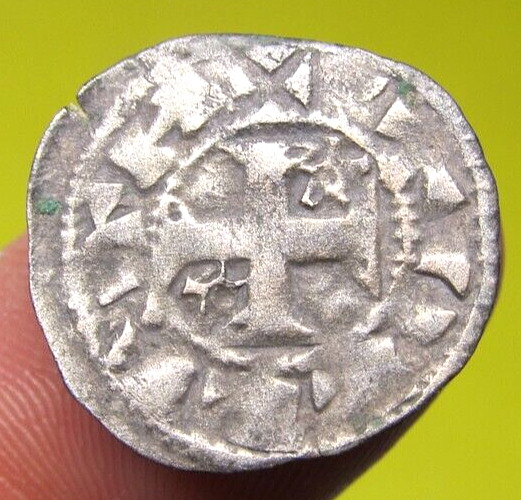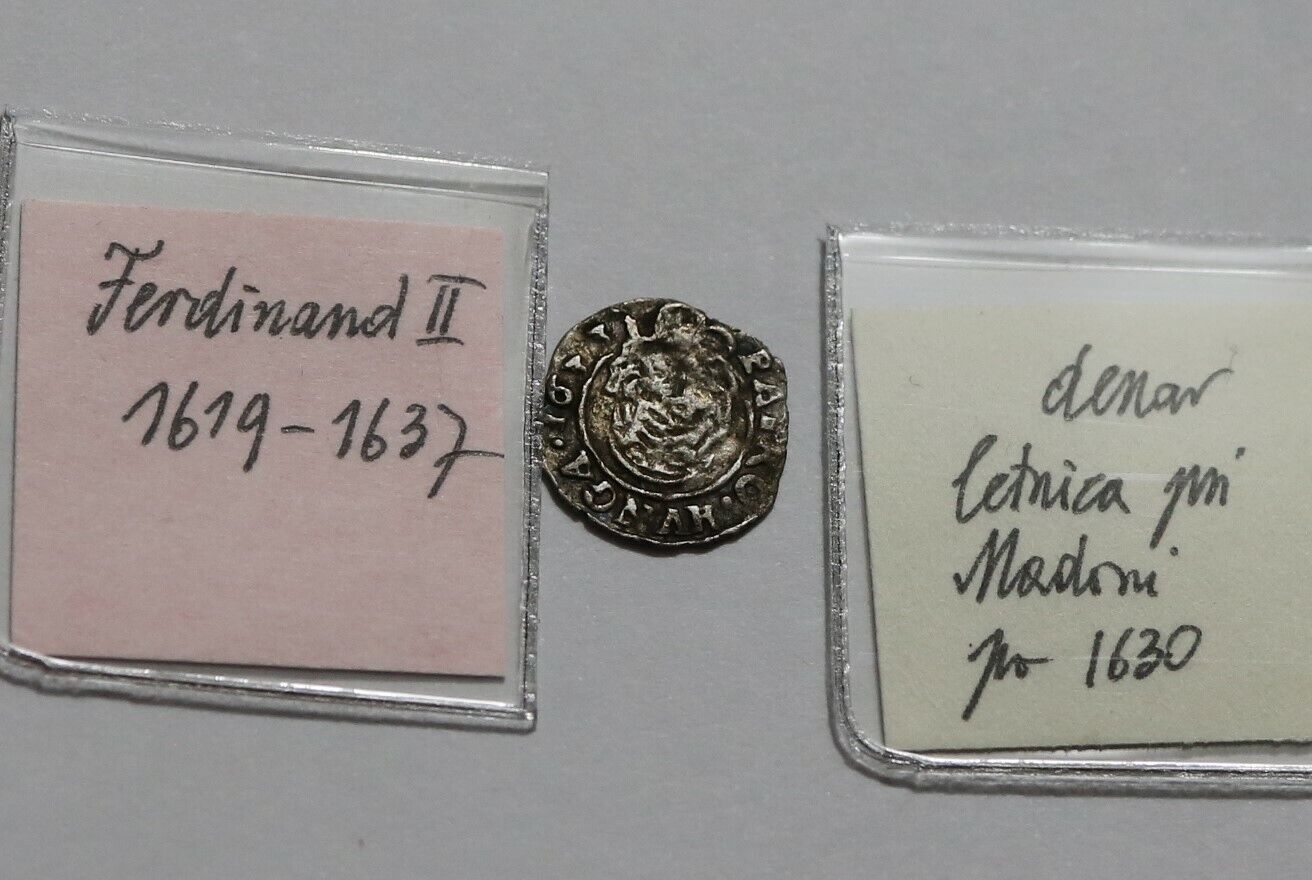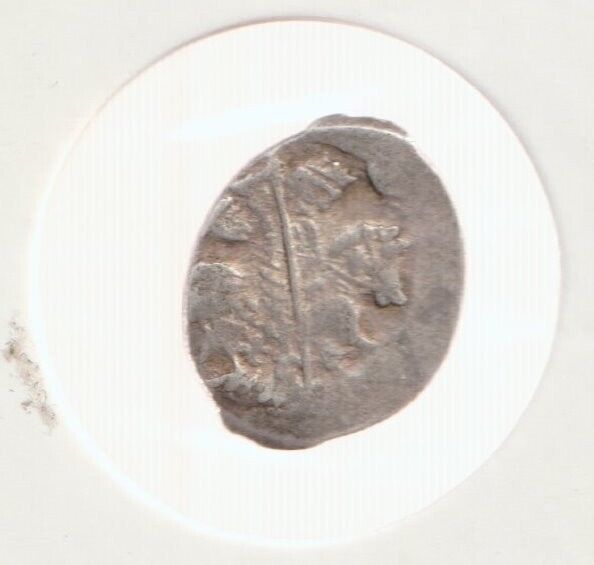-40%
Rare Silver Crusader French Feudal Coin Archbishops of Lyon 1050 AD Cross Castle
$ 102.96
- Description
- Size Guide
Description
French Feudal Coin: Archbishops of Lyon (1050-1100 AD)Obv: +PRIMA SEDES, central LG under '-'
Rev: +GALIARV, central cross.
Mint is Lyon
.
The coin dates 1050 - 1100 AD.
Original silver coin
measuring 18-19mm. in diameter
1.01gm. Lightly cleaned. Rare and interesting as pictured. Authenticity guaranteed.
You are bidding on the exact coins pictured and described above.
The Roman Catholic Archdiocese of Lyon (Latin: Archidioecesis Lugdunensis; French: Archidiocèse de Lyon), formerly the Archdiocese of Lyon–Vienne–Embrun, is a Roman Catholic Metropolitan archdiocese in France. The Archbishops of Lyon serve as successors to Saint Pothinus and Saint Irenaeus, the first and second bishops of Lyon, respectively, and are also called Primate of the Gauls. He is usually elevated to the rank of cardinal. Bishop Olivier de Germay was appointed Archbishop of Lyon on 22 October 2020.
The "Deacon of Vienne", who was martyred at Lyon during the persecution of 177, was probably a deacon installed at Vienne by the ecclesiastical authority of Lyon. The confluence of the Rhône and the Saône, where sixty Gallic tribes had erected the famous altar to Rome and Augustus, was also the centre from which Christianity was gradually propagated throughout Gaul. The presence at Lyon of numerous Asiatic Christians and their almost daily communications with the Orient were likely to arouse the susceptibilities of the Gallo-Romans. A persecution arose under Marcus Aurelius. Its victims at Lyon numbered forty-eight, half of them of Greek origin, half Gallo-Roman, among others Saint Blandina, and Saint Pothinus, first Bishop of Lyon, sent to Gaul by Saint Polycarp about the middle of the 2nd century. The legend according to which he was sent by Saint Clement dates from the 12th century and is without foundation. The letter addressed to the Christians of Asia and Phrygia in the name of the faithful of Vienne and Lyon, and relating the persecution of 177, is considered by Ernest Renan as one of the most extraordinary documents possessed by any literature; it is the baptismal certificate of Christianity in France. The successor of Saint Pothinus was the illustrious Saint Irenaeus (177-202). The discovery on the Hill of Saint Sebastian of ruins of a naumachia capable of being transformed into an amphitheatre, and of some fragments of inscriptions apparently belonging to an altar of Augustus, has led several archæologists to believe that the martyrs of Lyon suffered death on this hill. Very ancient tradition, however, represents the church of Ainay as erected at the place of their martyrdom. The crypt of Saint Pothinus, under the choir of the church of St. Nizier, was destroyed in 1884. But there are still revered at Lyon the prison cell of Saint Pothinus, where Anne of Austria, Louis XIV, and Pius VII came to pray, and the crypt of Saint Irenaeus built at the end of the 5th century by Saint Patiens, which contains the body of Saint Irenaeus. There are numerous funerary inscriptions of primitive Christianity in Lyon; the earliest dates from the year 334. In the 2nd and 3rd centuries, the See of Lyon enjoyed great renown throughout Gaul: witness the local legends of Besançon and of several other cities relative to the missionaries sent out by Saint Irenaeus. Faustinus, bishop in the second half of the 3rd century, wrote to Saint Cyprian and Pope Stephen I, in 254, regarding the Novatian tendencies of Marcian, Bishop of Arles. But when Diocletian's new provincial organization (tetrarchy) had taken away from Lyon its position as metropolis of the three Gauls, the prestige of Lyon diminished for a time.
At the end of the empire and during the Merovingian period several saints, as follows, are counted among the Bishops of Lyon. Saint Justus (374-381) who died in a monastery in the Thebaid (Egypt) and was renowned for the orthodoxy of his doctrine in the struggle against Arianism (the church of the Maccabees, whither his body was brought, was as early as the 5th century a place of pilgrimage under the name of the collegiate church of Saint Justus). Saint Alpinus and Saint Martin (disciple of Saint Martin of Tours; end of 4th century); Saint Antiochus (400-410); Saint Elpidius (410-422); Saint Sicarius (422-33); Saint Eucherius (c. 433-50), a monk of Lérins and the author of homilies, from whom doubtless dates the foundation at Lyon of the "hermitages" of which more will be said below; Saint Patiens (456-98) who successfully combated the famine and Arianism, and whom Sidonius Apollinaris praised in a poem; Saint Lupicinus (491-94); Saint Rusticus (494-501); Saint Stephanus (d. before 515), who with Saint Avitus of Vienne convoked a council at Lyon for the conversion of the Arians; Saint Viventiolus (515-523), who in 517 presided with Saint Avitus at the Council of Epaone; Saint Lupus, a monk, afterwards bishop (535-42), probably the first archbishop, who when signing in 438 the Council of Orléans added the title of "metropolitanus"; Saint Sardot or Sacerdos (549-542), who presided in 549 at the Council of Orléans, and who obtained from King Childebert the foundation of the general hospital; Saint Nicetius or Nizier (552-73), who received from the pope the title of patriarch, and whose tomb was honoured by miracles. The prestige of Saint Nicetius was lasting; his successor Saint Priseus (573-588) bore the title of patriarch, and brought the council of 585 to decide that national synods should be convened every three years at the instance of the patriarch and of the king; Saint Ætherius (588-603), who was a correspondent of Saint Gregory the Great and who perhaps consecrated Saint Augustine, the Apostle of England; Saint Aredius (603-615); Saint Annemundus or Chamond (c. 650), friend of Saint Wilfrid, godfather of Clotaire III, put to death by Ebroin together with his brother, and patron of the town of Saint-Chamond, Loire; Saint Genesius or Genes (660-679 or 680), Benedictine abbot of Fontenelle, grand almoner and minister of Queen Bathilde; Saint Lambertus (c. 680-690), also abbot of Fontenelle.[5] At the end of the 5th century Lyon was the capital of the Kingdom of Burgundy, but after 534 it passed under the domination of the kings of France. Ravaged by the Saracens in 725, the city was restored through the liberality of Charlemagne who established a rich library in the monastery of Ile Barbe. In the time of Saint Patiens and the priest Constans (d. 488) the school of Lyon was famous; Sidonius Apollinaris was educated there. The letter of Leidrade to Charlemagne (807) shows the care taken by the emperor for the restoration of learning in Lyon. With the aid of the deacon Florus he made the school so prosperous that in the 10th century Englishmen went there to study.
Under Charlemagne and his immediate successors, the Bishops of Lyon, whose ascendancy was attested by the number of councils over which they were called to preside, played an important theological part. Adoptionism had no more active enemies than Leidrade (798-814) and Agobard (814-840). When Felix of Urgel continued rebellious to the condemnations pronounced against adoptionism from 791-799 by the Councils of Ciutad, Friuli, Ratisbon, Frankfort, and Rome, Charlemagne conceived the idea of sending to Urgel with Nebridius, Bishop of Narbonne, Benedict of Aniane, and Archbishop Leidrade, a native of Nuremberg and Charlemagne's librarian. They preached against Adoptionism in Spain, conducted Felix in 799 to the Council of Aachen where he seemed to submit to the arguments of Alcuin, and then brought him back to his diocese. But the submission of Felix was not complete; Agobard, "Chorepiscopus" of Lyon, convicted him anew of adoptionism in a secret conference, and when Felix died in 815 there was found among his papers a treatise in which he professed adoptionism. Then Agobard, who had become Archbishop of Lyon in 814 after Leidrade's retirement to the Abbey of St. Medard, Soissons, composed a long treatise against that heresy. Agobard Agobard displayed great activity as a pastor and a publicist in his opposition to the Jews and to various superstitions. His rooted hatred for all superstition led him in his treatise on images into certain expressions which savoured of Iconoclasm. The five historical treatises which he wrote in 833 to justify the deposition of Louis the Pious, who had been his benefactor, are a stain on his life. Louis the Pious, having been restored to power, caused Agobard to be deposed in 835 by the Council of Thionville, but three years later gave him back his see, in which he died in 840. During the exile of Agobard the See of Lyon had been for a short time administered by Amalarius of Metz, whom the deacon Florus charged with heretical opinions regarding the "triforme corpus Christi", and who took part in the controversies with Gottschalk on the subject of predestination. Amolon (841-852) and Saint Remy (852-75) continued the struggle against the heresy of Valence, which condemned this heresy, and also was engaged in strife with Hincmar. From 879-1032 Lyon formed part of the Kingdom of Provence and afterwards of the second Kingdom of Burgundy. In 1032 Rudolph III of Burgundy died and his kingdom eventually went to Conrad II. The portion of Lyon situated on the left bank of the Saône became, at least nominally, an imperial city. Finally Archbishop Burchard II, brother of Rudolph, claimed rights of sovereignty over Lyon as inherited from his mother, Matilda, daughter of Louis IV of France; in this way the government of Lyon, instead of being exercised by the distant emperor, became a matter of dispute between the counts who claimed the inheritance and the successive archbishops. Lyon attracted the attention of Cardinal Hildebrand, who held a council there in 1055 against the simoniacal bishops. In 1076, as Gregory VII, he deposed Archbishop Humbert (1063–76) for simony. Saint Gebuin (Jubinus), who succeeded Humbert, was the confidant of Gregory VII and contributed to the reform of the Church by the two councils of 1080 and 1082, at which were excommunicated Manasses of Reims, Fulk of Anjou, and the monks of Marmoutiers. It was under the episcopate of Saint Gebuin that Gregory VII (20 April 1079) established the primacy of the Church of Lyon over the Provinces of Rouen, Tours, and Sens, which primacy was specially confirmed by Callistus II, despite the letter written to him in 1126 by Louis VI in favour of the church of Sens. As far as it regarded the Province of Rouen this letter was later suppressed by a decree of the king's council in 1702, at the request of Jacques-Nicolas Colbert, Archbishop of Rouen. Hugh of Die (1081–1106), the successor of Saint Gebuin, friend of Saint Anselm, and for a while legate of Gregory VII in France and Burgundy, had differences later on with Victor III, who excommunicated him for a time. The latter pope came to Lyon in 1106, consecrated the church of Ainay Abbey, and dedicated one of its altars in honour of the Immaculate Conception. The Feast of the Immaculate Conception was solemnized at Lyon about 1128, perhaps at the instance of Saint Anselm of Canterbury, and Saint Bernard wrote to the canons of Lyon to complain that they should not have instituted a feast without consulting the pope. Sovereignty As soon as Thomas Becket, Archbishop of Canterbury, had been proclaimed Blessed (1173), his cult was instituted at Lyon. Lyon of the 12th century thus has a glorious place in the history of Catholic liturgy and even of dogma, but the 12th century was also marked by the heresy of Peter Waldo and the Waldenses, the Poor Men of Lyon, who were opposed by John of Canterbury (1181–1193), and by an important change in the political situation of the archbishops. In 1157 Emperor Frederick Barbarossa confirmed the sovereignty of the Archbishops of Lyon; thenceforth there was a lively contest between them and the counts. An arbitration effected by the pope in 1167 had no result, but by the treaty of 1173, Guy, Count of Forez, ceded to the canons of the primatial church of St. John his title of count of Lyon and his temporal authority. Then came the growth of the Commune, more belated in Lyon than in many other cities, but in 1193 the archbishop had to make some concession to the citizens. The 13th century was a period of conflict. Three times, in 1207, 1269, and 1290, grave troubles broke out between the partisans of the archbishop who dwelt in the château of Pierre Seize, those of the count-canons who lived in a separate quarter near the cathedral, and partisans of the townsfolk. Gregory X attempted without success to restore peace by two Acts, 2 April 1273 and 11 November 1274. The kings of France were always inclined to side with the commune; after the siege of Lyon by Louis X (1310), the treaty of 10 April 1312 definitively attached Lyon to the Kingdom of France, but until the beginning of the 15th century the Church of Lyon was allowed to coin its own money. If the 13th century had imperiled the political sovereignty of the archbishops, it had on the other hand made Lyon a kind of second Rome. Gregory X was a former canon of Lyon, while Innocent V, as Peter of Tarantaise, was Archbishop of Lyon from 1272 to 1273. Innocent IV and Gregory X sought refuge at Lyon from the Hohenstaufen, and held there two general councils of Lyon. Local tradition relates that it was on seeing the red hat of the canons of Lyon that the courtiers of Innocent IV conceived the idea of obtaining from the Council of Lyon its decree that the cardinals should henceforth wear red hats. The sojourn of Innocent IV at Lyon was marked by numerous works of public utility, to which the pope gave vigorous encouragement. He granted indulgences to the faithful who should assist in the construction of the bridge over the Rhône, replacing that destroyed about 1190 by the passage of the troops of Richard Cœur de Lion on their way to the Crusade. The building of the churches of St. John and St. Justus was pushed forward with activity; he sent delegates even to England to solicit alms for this purpose and he consecrated the high altar in both churches. At Lyon were crowned Clement V (1305) and Pope John XXII (1310); at Lyon in 1449 the antipope Felix V renounced the tiara; there, too, was held in 1512, without any definite conclusion, the last session of the schismatical Council of Pisa against Julius II. In 1560 the Calvinists took Lyon by surprise, but they were driven out by Antoine d'Albon, Abbot of Savigny and later Archbishop of Lyon. Again masters of Lyon in 1562, they were driven thence by the Maréchal de Vieuville. At the command of the famous Baron des Adrets they committed numerous acts of violence in the region of Montbrison. It was at Lyon that Henry IV of France, the converted Calvinist king, married Marie de' Medici (9 December 1600).
Items will be shipped within 1 to 3 business days of purchase completion.
FREE domestic SHIPPING
INTERNATIONAL .99
(REGISTERED-.00) WE COMBINE SHIPPING.
If you would like to have special shipping, please contact us.
All items will be sent out in protected envelope and boxed if necessary.
YOU ARE BIDDING ON AN ANCIENT ITEM(S) AS DESCRIBED AND PICTURED ABOVE!!!
Every item offered by cameleoncoins is unconditionally guaranteed to be genuine & authentic.
We can provide a certificate of authenticity or extended return policy by request only!!!
Please include 5 dollars and a short request with your payment if you would like a COA!!!
If in the unlikely event that an item is found to be reproduction, full return privileges are within 14 days of receiving the coins. We will promptly offer a full refund without hesitation or hassle.












